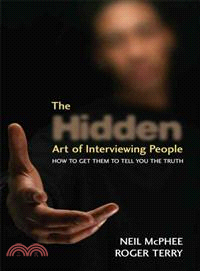| FindBook |
|
有 1 項符合
NEIL MCPHEE的圖書 |
 |
$ 2223 | THE HIDDEN ART OF INTERVIEWING PEOPLE
作者:NEIL MCPHEE / 譯者:ROBERT TERRY 出版社:JOHN WILEY & SONS,LTD 出版日期:2007-04-13 規格: / 精裝 / 384頁  看圖書介紹 看圖書介紹
|
|
|
- 圖書簡介
There is growing interest in the use of Neuro Linguistic Programming (NLP) as a Qualitative Market Research technique. NLP was previously used in psychology to understand how people think and react, and as a tool in self-development, interpersonal skills and business, looking at how our brains think and experience the world.
Qualitative Market research experts now see that using NLP can help the researchers understand the human brain and, armed with this power, they can find out the truth from interviewees. The Hidden Art of Interviewing People shows how, by using NLP and related techniques in interviews, the market researcher can see beyond the obvious to the truth. - 作者簡介
Neil McPhee is a long-time qualitative researcher, who began his career in 1972. Having been told by his boss, in his first week's employment in research, to go and help out with some interviewing (of retired people, applying for old-age bus concession passes), he discovered his probable incompatibility with structure by omitting to fill out any questionnaires at all. Some 25 years ago, Neil was introduced to new thinking at a presentation on Nonverbal Communication and Body Language. He became sold on the possible applications and the subject in general. Soon after that, Neil discovered NLP. There was little turning back after that. You cannot unlearn something so potent and pretend that none of it existed. Since then, Neil has variously bought, run and sold his own full-service agency and worked as Qualitative Research Director for an American-owned agency. He now offers his services as a Qualitative/Ethnography Practitioner and Consultant, both in the UK and internationally. Neil trained in NLP/Hypnotherapy with Roger Terry.
Roger Terry is a scientist with over 25 years' experience in running and building successful businesses. Ten years ago, he founded Evolution Training with his partner Emily, and he now works with businesses and individuals, guiding them to evolve to their full potential. Previously, his career was within the utility sector, where he was responsible for new business creation and innovative business development. An international NLP Master Trainer, hypnosis instructor and expert on human value systems, Roger leads seminars and consults with companies on executive teams in the UK, USA, Europe and the Middle East. His expertise in cultural change has helped businesses revitalise their organisations and people, bringing their cultures in line with the business strategy required to produce profit and growth. With a talent for using Neuro-Linguistic Programming and personal development techniques, Roger has a pragmatic and practical style. His enthusiastic and forthright approach to coaching, with a focused Neuro-Linguistic Programming methodology, provides a unique intervention approach that allows a client to achieve the maximum movement in their chosen direction for minimum effort. - 目次
FOREWORD.
ACKNOWLEDGEMENTS.
ABOUT THE AUTHORS.
INTRODUCTION.
1 TAKING THE BRIEF.
What’s in this chapter?
The importance of the fi rst steps.
Being at your best.
The dance of communication.
Reading the signposts.
True listening.
Quality questions.
Eliciting values.
Setting the scene – NLP frames.
Checklist for taking the brief.
2 RESPONDING TO THE BRIEF.
What’s in this chapter?
What’s the point of writing a proposal?
Proposal or action plan?
The power of words.
Using values to enhance the action plan.
Document style and construction.
Thinking like the client.
Action plan writing guidelines.
3 THE SAMPLE.
What’s in this chapter?
Recruitment.
Characteristics.
VAK subquotas.
Recruitment approaches.
4 RESEARCH INTERVIEWS.
What’s in this chapter?
Overview.
How we create our reality.
How does the process of fi lters and communication work?
Reframing.
Envirometics.
Rapport.
Role.
The topic guide.
Handling individuals.
Animating the group.
Groups vs depths.
Projective and enabling techniques.
5 UNDERSTANDING WHY PEOPLE BEHAVE THE WAY THEY DO.
What’s in this chapter?
Understanding people.
The fi ve sensory fi lters.
Eye accessing cues.
Primary interest or focus of attention.
Global–specifi c: chunk size.
Relational sort for decision: sameness–difference (matching–mismatching).
Motivating attention fi lters.
Options–procedures.
Time sort: past, present, future.
Decision-making.
Usage.
6 THE ANALYSIS.
What’s in this chapter?
To analyse or not to analyse?
One way of working.
Recording the interview.
Analysis.
How do we elicit this information?
Summary.
7 PRESENTING YOUR FINDINGS.
What’s in this chapter?
Putting it all together.
The presentation process.
Videoconferencing.
8 ETHICS, ECOLOGY AND CODES OF PRACTICE.
What’s in this chapter?
What do we mean by ecology?
Manipulation.
Ecology: NLP style.
Ethics and qualifi cations.
Codes of practice.
9 CONVERSATION PIECES.
GLOSSARY.
REFERENCES.
INDEX.
|











